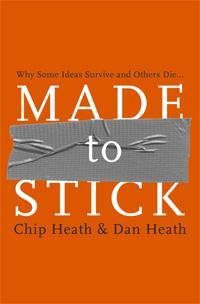Made to Stick
Why do some ideas stick and others seem forgotten even before they’ve finish being said? As teachers, fundraisers, and friends we are constantly communicating ideas that we believe are important. But what makes one idea remembered and another forgotten? Made to Stick, Why Some Ideas Survive and Some Die, articulates six characteristic of ideas people remember. The authors, who work in the fields of publishing and higher education, have researched their subject with a vested interest. Their short book is filled with clear points and memorable illustrations. It offers one of those acrostics we love to hate: SUCCES. Ideas that stick are:
Simple
Not the kind of simplicity that is shallow or comes quickly, but the kind of simplicity that results from careful selection and prioritization. Let’s face it; life is complex and there is a lot of information offered to all of us through many channels. What is the really important point of a message? How can our idea boils down to something profound?
Unexpected
The twist of a plot or the surprise present is out of the ordinary and stand out in our minds. Preaching books talk about the “reversal” in the flow of a sermon. The answer is not what you expected; it is unexpected. Suddenly we pay more attention and think about an idea more because it comes as a surprise and that helps it stick.
Concrete
Experts often express big, vague concepts, but ideas associated with a specific, concrete image are easer for our minds to remember. Our minds are like Velcro. The more little hooks (concrete images) an idea has the better it sticks. It is the difference between Aesop’s fable about the tortoise and the hare and a long explanation of perseverance compared to the relative benefits of short bursts of speed.
Credible
Actually, remembering is not enough; we hope our ideas are believed. In our information flooded world sticky idea need to carry their own authentication. Instead of trying to pile up more and more evidence, a secret may be in leading people test for themselves. Authority, past experience, and details are all sources of credibility, but in the end the testable credential will carry the most weight.
Emotional
Advertisers know that most of us make decision based on our emotions not the careful rational comparison of facts. If you want to get people to do something, get them to feel something. We are wired to respond emotionally. Often the trick is figuring out what emotions are actually helpful in making an appeal.
Story
Most of us remember stories speakers tell far longer than the points of their outlines. Stories are filled with the details and concrete connections that help us imagine ourselves in a situation. Stories contextualize ideas and create images in our minds. The key is finding the right stories to help our ideas stick and the book has a number of helpful hints.
Definitely worth the read! Made to Stick, Why Some Ideas Survive and Other Die, Chip Heath and Dan Heath, Random House, 2007


